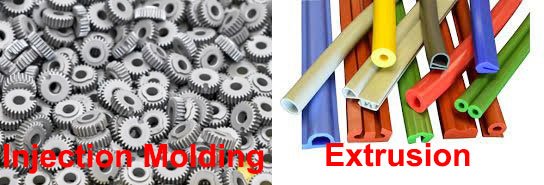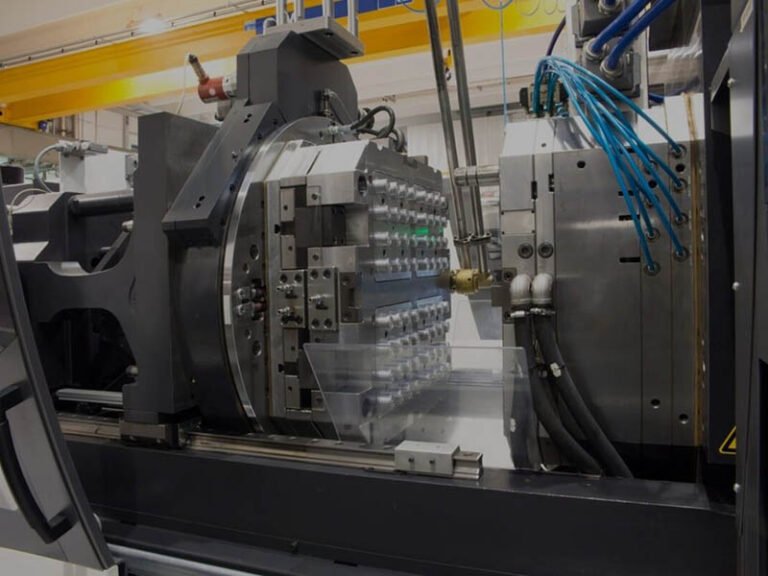There are many manufacturing methods for custom plastic parts. Such as injection molding, compression molding, insert molding, overmolding, extrusion, etc. The methods employed can significantly impact the quality, efficiency, and cost-effectiveness of the final products. In today’s exploration, we delve into two widely used manufacturing techniques – injection molding vs extrusion. Although their production processes all require heating raw materials to deform, they have different characteristics and applications.
What is Injection Molding?
Injection molding is a highly versatile and widely-used manufacturing process that involves the creation of plastic parts and products by injecting molten plastic material into a precision-designed mold cavity. Once the material cools and solidifies within the mold, it takes on the desired shape and characteristics. Injection molding is known for its exceptional precision, allowing for the production of intricate and complex parts with consistent quality.
What is Extrusion?
Extrusion is a continuous manufacturing process that involves shaping materials, typically in a heated and softened state, by forcing them through a specially designed die. This process results in the creation of continuous profiles, such as pipes, tubes, sheets, and various other linear or cross-sectional shapes. Extrusion is known for its efficiency in producing long, uniform lengths of materials with consistent cross-sections.
What are injection molding vs extrusion differences? In this post, we will compare injection molding and extrusion in terms of key factors.
Injection Molding vs Extrusion Process
Injection molding and extrusion are two distinct manufacturing processes, but they do share some similarities. In both processes, raw materials are heated and melted before they are shaped into the desired form. Both processes require the design and fabrication of molds or dies to shape the material into the desired geometry. After the material is shaped, it undergoes a cooling process to solidify it into the final product or shape.
In addition to these similarities, next, I will introduce the differences between the two processes in the manufacturing process.
Injection Molding Process
The injection molding process is a manufacturing method used to create plastic parts and products by injecting molten plastic material into a mold cavity. It is best for intricate, three-dimensional parts with precise details. This process involves several stages, and there are typically four primary stages in injection molding:
- Clamping: In this initial stage, the two halves of the mold, referred to as the “mold halves” or “mold plates,” are securely closed and clamped together with great force.
- Injection: The raw material is injected under high pressure into the mold cavity through a nozzle and sprue.
- Cooling: After the molten plastic has filled the mold cavity and taken the desired shape, it begins to cool and solidify.
- Ejection: Once the plastic part has sufficiently cooled and solidified, the mold opens, and the finished part is ejected from the mold cavity.
Extrusion Process
The extrusion process is a manufacturing method used to create continuous lengths of materials with specific cross-sectional shapes. The extrusion process typically involves several stages, and there are three primary stages in the extrusion process:
- Material Preparation: The first stage involves preparing the raw material is loaded into a hopper, which feeds it into an extruder.
- Extrusion: In this stage, the molten material is forced through a specially designed die. This results in the creation of a continuous profile or length of material with the desired cross-section.
- Cooling and Sizing: After the material has passed through the die, it enters a cooling process to solidify it into its final form. The product is then passed through sizing or calibration equipment, which ensures that it meets the precise dimensions and tolerances required.

Injection Molding VS Extrusion Machine and Work Principle
Injection Molding Machine and Principle
The injection molding process is mainly achieved through the use of an injection molding machine and molds. Molds are designed based on the shape characteristics of the product and are then used with the injection molding machine to achieve rapid production. This process is like a customized tool that can inject molten plastic into the molds, creating various plastic products with different shapes.

Extrusion Machine and Working Principle
An extrusion machine, also known as an extruder, is a specialized piece of equipment used in the extrusion process to shape and produce continuous lengths of materials with specific cross-sectional shapes. It works on the principle of forcing a material, often in a molten or softened state, through a specially designed die to create a continuous profile or product.

Injection Molding Vs Extrusion Materials
Injection molding and extrusion are two distinct manufacturing processes, and they often use different materials with specific characteristics suited to their respective methods. Here’s a comparison of the material characteristics for injection molding and extrusion:
Injection Molding Material Characteristics:
- Melt Flowability: Injection molding materials need to have good melt flowability to fill complex mold cavities and create intricate part features. High melt flow materials work well in injection molding.
- Solidification Rate: Materials for injection molding should solidify relatively quickly to allow for shorter cycle times. Rapid solidification helps in achieving high production rates.
- Uniformity: Injection molding requires materials with uniform properties to ensure consistent part quality. Inconsistent material properties can result in defects.
- Dimensional Stability: Materials should exhibit good dimensional stability to prevent warping or distortion of molded parts during cooling and solidification.
- High Impact Strength: Many injection-molded products, especially those in the automotive and consumer goods industries, require materials with high impact resistance to withstand mechanical stresses.
Extrusion Material Characteristics:
- Melt Viscosity: Extrusion materials need to have controlled melt viscosity to ensure they flow evenly through the extruder and die. High-melt viscosity materials can be effectively processed through extrusion.
- Continuous Processing: Extrusion is a continuous process, so materials should have consistent properties to maintain uniformity over extended production runs.
- Thermal Stability: Extrusion materials must be stable at elevated temperatures because they are heated during the process. This stability prevents degradation during extrusion.
- Cross-Sectional Consistency: Extrusion materials need to maintain consistent cross-sectional shapes and dimensions over long lengths.
For example, Liquide Silicone Rubber (LSR).
LSR is well-suited for injection molding due to its unique properties. It’s a liquid material that cures into a flexible elastomer when exposed to heat. But, LSR is not suitable for extrusion. Its liquid nature and curing process do not align with the continuous, solid-state extrusion process. Extruding LSR would be impractical and ineffective.
Injection Molding vs Extrusion Advantages and Disadvantages
Injection Molding Advantages:
- High Precision: Injection molding allows for the production of highly detailed and intricate parts with tight tolerances. This precision is well-suited for complex components.
- Wide Material Selection: It is compatible with a wide range of materials, including various thermoplastics and thermosetting plastics, offering versatility in material choices.
- Short Cycle Times: Injection molding can achieve rapid cycle times, making it efficient for high-volume production. Click here to learn more details about injection molding cycle time.
- Minimal Material Waste: Excess material can often be recycled, reducing material waste and cost.
- Highly Automated: The process is highly automated, requiring minimal manual labor once set up.
Injection Molding Disadvantages:
- High Initial Costs:Setting up injection molding requires expensive molds and machinery, making it less feasible for small-scale production.
- Complex Mold Design:Complex molds are often required for intricate parts, which can increase design and tooling costs.
Extrusion Advantages:
- Continuous Process: Extrusion is a continuous process, allowing for the production of long lengths of material with consistent cross-sections, making it efficient for certain products.
- Lower Tooling Costs: Compared to injection molding, extrusion often involves lower tooling and mold costs, making it more accessible for smaller production runs.
- Material Efficiency: Extrusion materials are used efficiently, with little waste, especially in processes like profile extrusion.
Extrusion Disadvantages:
- Limited Precision:Extrusion typically offers lower precision compared to injection molding, making it less suitable for intricate parts.
- Material Constraints:Material choices for extrusion may be more limited, and not all materials are suitable for the process.
Injection Molding vs Extrusion Cost
What is the difference between injection molding cost and extrusion cost? Which process is cheaper? Actually, determining whether injection molding or extrusion is cheaper depends on various factors, including the specific project, material, production volume, and product design.
Here is a table to compare the two processes’ costs.
| Cost Consideration | Injection Molding | Extrusion Molding |
|---|---|---|
| Tooling Costs | High | Low |
| Machine Costs | High | Low |
| Material Costs | Depending on the type of material used, a wide range of available | Depending on the type of material used |
| Labor Costs | Includes machine setup, quality control, and maintenance | Similar to injection molding, labor costs for machine operation |
Choose the Right Process for Your Project
In general, extrusion tends to be more cost-effective for producing continuous lengths of products with consistent cross-sections, such as pipes, tubes, and simple profiles. It’s often used for high-volume production of products like these.
Injection molding, on the other hand, is preferred for producing complex and intricately shaped parts. While it has higher tooling and machine costs, it can be cost-effective for large-scale production of intricate components.
Conclusion
In summary, injection molding and extrusion are two distinct manufacturing processes, each with its own strengths. The choice between injection molding and extrusion ultimately depends on the specific requirements of your project. Whether you need intricate, custom-designed components or high-volume, continuous-length products, there’s a manufacturing method that’s just right for you.
If you’re considering either of these methods for your manufacturing needs or have any questions about molding processes, we invite you to explore further with Zhongde, your trusted on-demand China manufacturer. Our expert team is here to assist you in bringing your ideas to life and delivering high-quality products that meet your exact specifications.




